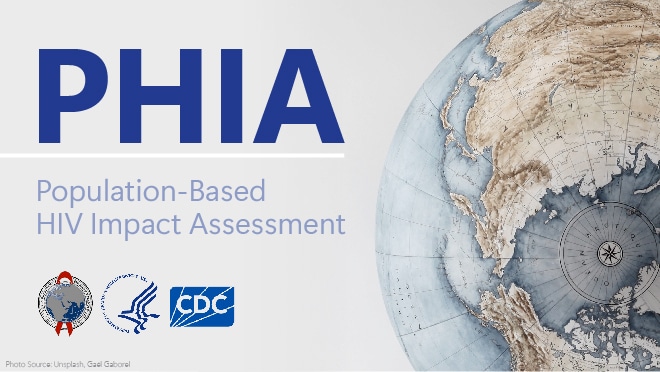At a glance
HIV is a leading cause of death and a health threat to millions worldwide. As a key PEPFAR implementing agency, CDC plays a unique role—bringing a combination of scientific expertise, technical know-how, and strong partnerships to bear in the fight against HIV. CDC continues to lead the way in HIV prevention and treatment at home and abroad, working to eliminate HIV and save lives.
Leading progress to end the global HIV epidemic

More than four decades since the first cases were reported, HIV remains a leading cause of death worldwide. Innovations in HIV care, treatment, and prevention help people with HIV enjoy longer, healthier lives. However, many people do not benefit from these scientific advances, mainly due to stigma and discrimination.
Core strategies for sustaining progress and ending HIV as an epidemic include:
- Strong partnerships,
- Dedication to eliminating stigma and discrimination,
- Ensuring access to quality, people-centered HIV services, and
- Ensuring HIV treatment and prevention programs reach disproportionately impacted populations.
CDC is a key implementing partner of the U.S. President's Emergency Plan for AIDS Relief (PEPFAR). We work with partners to improve methods for finding, treating, and preventing HIV. The investments made today will save lives, strengthen communities, and pave the way for long-term sustainability.
Eliminating HIV as a global public health threat

The U.S. President's Emergency Plan for AIDS Relief, or PEPFAR, was announced in 2003. When it was launched, PEPFAR became the largest commitment by any nation to address a single disease in history. At the time, HIV was a global crisis, devastating families, communities, and economies worldwide—particularly in sub-Saharan African countries. As a key implementing agency of PEPFAR, CDC has played a critical role since its inception. With over four decades of scientific and technical expertise, CDC is helping to transform some of the world's most severe epidemics.
A study published in CDC's Morbidity and Mortality Weekly Report in 2023 revealed PEPFAR's impact and contributions by partners, including CDC. Since 2004, the number of people with HIV receiving lifesaving treatment through PEPFAR increased an astonishing 300 times, from just 66,500 individuals in 2004 to more than 20 million people in 2022.
Vital Signs Report
What's being done

Population-Based HIV Impact Assessment (PHIAs) surveys are an important tool for measuring the impact of HIV treatment and prevention programs. CDC and partners use data and insights from PHIAs to improve programs. These timely adjustments lead to increased efficiencies and positive outcomes for community members, including people living with HIV. Learn more about PHIAs and the countries where surveys have been completed.
Support for CDC's global HIV and TB efforts.
Our success is built on the backbone of science and strong partnerships.
CDC’s global HIV impact
Learn how CDC and partners are adapting services and expanding key treatment and prevention activities to end HIV.
Latest publications
Latest studies from CDC on global HIV.
